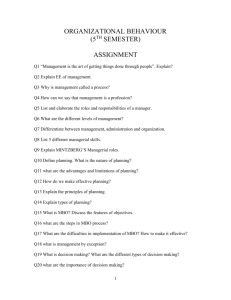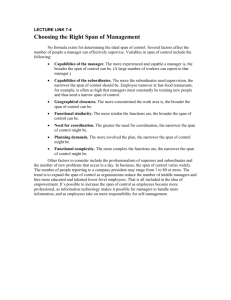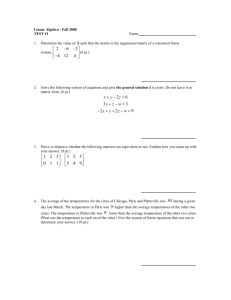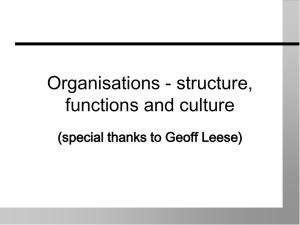Chapter 12 - Span of Management * Span of Management * Modern
advertisement
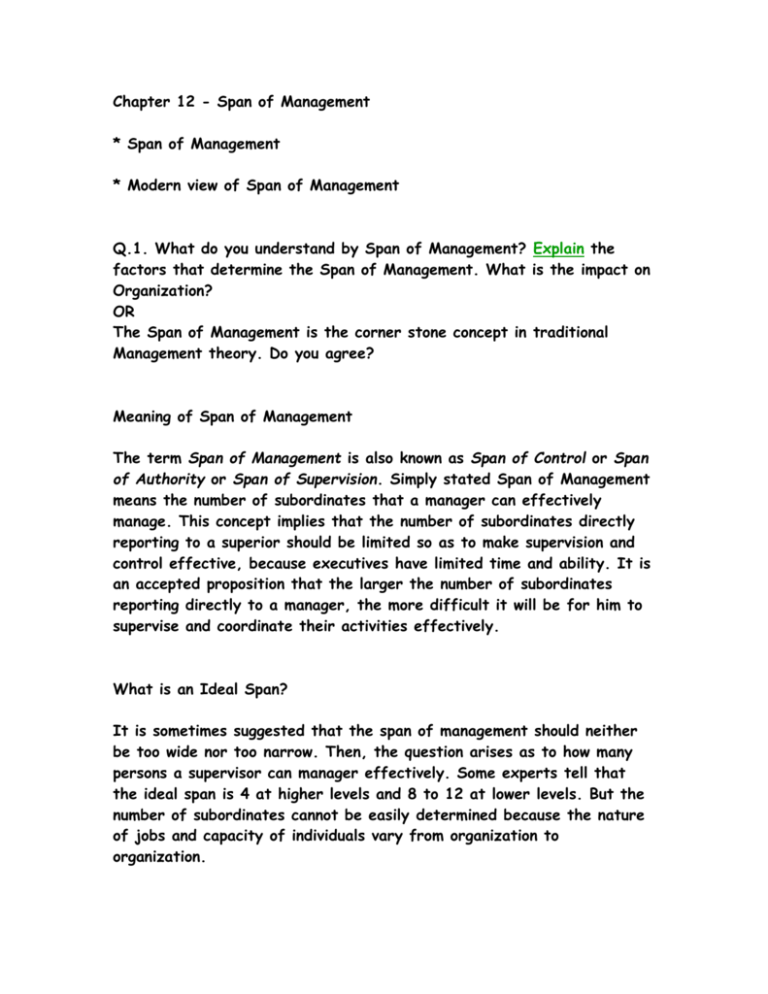
Chapter 12 - Span of Management * Span of Management * Modern view of Span of Management Q.1. What do you understand by Span of Management? Explain the factors that determine the Span of Management. What is the impact on Organization? OR The Span of Management is the corner stone concept in traditional Management theory. Do you agree? Meaning of Span of Management The term Span of Management is also known as Span of Control or Span of Authority or Span of Supervision. Simply stated Span of Management means the number of subordinates that a manager can effectively manage. This concept implies that the number of subordinates directly reporting to a superior should be limited so as to make supervision and control effective, because executives have limited time and ability. It is an accepted proposition that the larger the number of subordinates reporting directly to a manager, the more difficult it will be for him to supervise and coordinate their activities effectively. What is an Ideal Span? It is sometimes suggested that the span of management should neither be too wide nor too narrow. Then, the question arises as to how many persons a supervisor can manager effectively. Some experts tell that the ideal span is 4 at higher levels and 8 to 12 at lower levels. But the number of subordinates cannot be easily determined because the nature of jobs and capacity of individuals vary from organization to organization. Classical View of Span of Management The first person to draw attention to the principle of span of management was a British General, Sir Iaan Hamilton (1920) who said that the average human brain can be effective in handling from 3 to 6 other brains. After a lengthy study of military organisations, he concluded that the span should be smaller at the top of the organisation, where thought processes were more complicated and that it should set progressively larger toward the lower levels, where thought processes were less complicated and more routine. V.A. Graicunas (1933) suggested that as the number of subordinates increases arithetically, the number of potential relationships, between the superior and subordinates increases geometrically. For example, Graicunas indicates that if a superior manages 2 subordinates, there are actively 6 different relationships. Thus, he pointed out that an increase in the number of subordinates causes almost an explosive growth in the number of possible relationships. Hence, only number of bodies in a span should not be counted, but the multifarious relationships generated by the numbers must also be recognized while deciding for the span of individual manager. Classical writers advocated a span of control ranging from 3 to 7 or 8 persons at the higher levels and a span of 20 to 30 persons at the lowest level. Q.2. Describe the modern view of Span of Management. Modern View of Span of Management Contingency Or Situational Approach (Factors Determining Span of Management The evidences indicate that spans of control cannot be stated in absolute terms as done by the classical scholars. There is no correct span for all situations. The predominant current view is to look for the causes of limited span in individual situations, rather than to assume that there is a given numerical limit generally applicable to all. Pragmatically speaking, a really proper span of control is one that is not improper. Modern Approach has shifted away from trying to find out a universal formula of span of management. Instead of emphasizing absolute spans (specific numbers), the current view is that span is more flexible thing, and there is no one correct span for all situations. The appropriate number of span of control for a particular manager is contingent on several factors that may be discussed as follows: 1. The Capacity and Ability of the Superior The personal abilities and influence of the superior (manager) play an important role in determining the number of subordinates that can be effectively supervised by him. If the superior possesses qualities of leadership, decision-making ability, communication skill, motivating strength and time management expertise, in greater degree, that the span of control may be wider. In other words, if the superior (executive) can comprehend problems quickly, can get along well with people and can command loyalty and respect from the subordinates, then he can supervise a large number of subordinates effectively. 2. The Capacity and Skill of Subordinate In case the subordinates are competent, well trained, experienced and have good judgement, initiative and a sense of obligation, then they seek less guidance from their superior and therefore the superior manager will be in a position to supervise a large number of subordinates. On the other hand, if the manager has no confidence in the capacity and caliber of his subordinates, then the span will be restricted to be narrow.' 3. Nature and Importance of Work Supervised If the work is simple and repetitive, the span of management may be wider, because it does not require much attention and time on the part of the superior. On the other hand where the subordinate's job is complex requiring close supervision by the superior, then the number of persons under him should be narrow or small. Such characteristics generally indicate whether jobs are easy or complicated, dissimilarity of jobs assigned the number of new problems that may be encountered, the need for frequent consultations and communication, the physical dispersal of jobs, geographically location of members, nature of decision making by the subordinates and so on. The more a subordinate's job involves unpredictability, variety, discretion and responsibility, the smaller span is likely to be. 4. Clarity of Plans and Responsibility If the plans and policies are clear and easily understandable and if the functions and responsibilities are laid down in as definite terms as possible, the the task of supervision is easier and the span of management can be wider because the subordinates need not go to superior frequently for orders, instructions and guidance. 5. Degree of Decentralization If there is proper delegation and decentralization of authority, then the superior can successfully supervise a large number of subordinates, because in that case he has not to take any decisions himself and merely provides encouragement and occasional direction. In case of centralization of authority, the span will be narrow. 6. Staff Assistants When staff assistants (experts) are employed to advise and serve the superiors and the subordinates, then contract between the superior and the subordinates may be reduced and the span be broadened. The Impact of the Span of Organisation The actual span of supervision affects the organisation in different ways. The structure of organisation produced by the narrower span is called tall organisation, and the wider span produce what is known as flat organisation. The narrow span requires multiple levels of supervision and hence longer time for communication. Tall organisation is more expensive and complicates the process of communication and integration. A narrow span results in harassed subordinates and frustrated superiors. However, a narrow span enables managers to exercise close supervision and control and wherever these are needed, the narrow span is better suited. Conversely, a wider span results in fewer levels of supervision. The flat organisation facilitates better communication and coordination, but it permits only general supervision due to the limited availability of time. The wide span results in harassed superiors and frustrated subordinates. Robert House and John Miner (1969) have summarized the entire question of span of management as follows: 1. Under most circumstances the optional span is likely to be in the range of 5 to 10. 2. The larger spans (say 8 to 10) are most often appropriate at the highest policy making levels of an organisations. 3. The number of effective spans of first-line supervisors is contingent upon the technology of organisation. 4. Appropriate span for specific situations depends on a set of local factors (for example, task, interdependencies and leadership skills).




